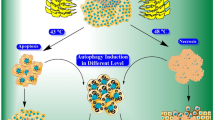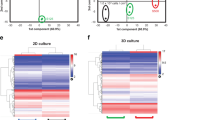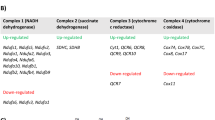Abstract
Photodynamic therapy (PDT) is an anticancer approach utilizing a light-absorbing molecule and visible light irradiation to generate, in the presence of O2, cytotoxic reactive oxygen species, which cause tumor ablation. Given that the photosensitizer hypericin is under consideration for PDT treatment of bladder cancer we used oligonucleotide microarrays in the T24 bladder cancer cell line to identify differentially expressed genes with therapeutic potential. This study reveals that the expression of several genes involved in various metabolic processes, stress-induced cell death, autophagy, proliferation, inflammation and carcinogenesis is strongly affected by PDT and pinpoints the coordinated induction of a cluster of genes involved in the unfolded protein response pathway after endoplasmic reticulum stress and in antioxidant response. Analysis of PDT-treated cells after p38MAPK inhibition or silencing unraveled that the induction of an important subset of differentially expressed genes regulating growth and invasion, as well as adaptive mechanisms against oxidative stress, is governed by this stress-activated kinase. Moreover, p38MAPK inhibition blocked autonomous regrowth and migration of cancer cells escaping PDT-induced cell death. This analysis identifies new molecular effectors of the cancer cell response to PDT opening attractive avenues to improve the therapeutic efficacy of hypericin-based PDT of bladder cancer.
This is a preview of subscription content, access via your institution
Access options
Subscribe to this journal
Receive 50 print issues and online access
$259.00 per year
only $5.18 per issue
Buy this article
- Purchase on Springer Link
- Instant access to full article PDF
Prices may be subject to local taxes which are calculated during checkout




Similar content being viewed by others
Abbreviations
- AREs:
-
adenylate/uridylate-rich elements
- ATF:
-
activating transcription factor
- Atg:
-
autophagy-related gene
- CHOP:
-
C/EBP homologous protein
- COX-2:
-
cyclooxygenase-2
- ECM:
-
extracellular matrix
- ER:
-
endoplasmic reticulum
- ERAD:
-
ER-associated degradation
- GO:
-
Gene Ontology
- GM-CSF:
-
granulocyte macrophage colony-stimulating factor
- HO-1:
-
heme oxygenase 1
- Hsp:
-
heat shock protein
- MAPK:
-
mitogen-activated protein kinase
- MMP:
-
matrix metalloproteinase
- Nrf2:
-
NF-E2-related factor 2
- PDT:
-
photodynamic therapy
- PG:
-
prostaglandin
- PERK:
-
pancreatic ER kinase (PKR)-like ER kinase
- ROS:
-
reactive oxygen species
- SERCA:
-
sarco(endo)plasmic-reticulum Ca2+-ATPase
- TCC:
-
transitional cell carcinoma
- UPR:
-
unfolded protein response
References
Agostinis P, Buytaert E, Breyssens H, Hendrickx N . (2004). Regulatory pathways in photodynamic therapy induced apoptosis. Photochem Photobiol Sci 3: 721–729.
Assefa Z, Vantieghem A, Declercq W, Vandenabeele P, Vandenheede JR, Merlevede W et al. (1999). The activation of the c-Jun N-terminal kinase and p38 mitogen-activated protein kinase signaling pathways protects HeLa cells from apoptosis following photodynamic therapy with hypericin. J Biol Chem 274: 8788–8796.
Benjamini Y, Hochberg Y . (1995). Controlling the false discovery rate: a practical and powerful approach to multiple testing. J R Stat Soc, B 57: 289–300.
Birney E, Andrews D, Caccamo M, Chen Y, Clarke L, Coates G et al. (2006). Ensembl 2006. Nucleic Acids Res 34: D556–D561.
Bostrom PJ, Ravanti L, Reunanen N, Aaltonen V, Soderstrom KO, Kahari VM et al. (2000). Expression of collagenase-3 (matrix metalloproteinase-13) in transitional-cell carcinoma of the urinary bladder. Int J Cancer 88: 417–423.
Buytaert E, Callewaert G, Hendrickx N, Scorrano L, Hartmann D, Missiaen L et al. (2006). Role of endoplasmic reticulum depletion and multidomain proapoptotic BAX and BAK proteins in shaping cell death after hypericin-mediated photodynamic therapy. FASEB J 20: 756–758.
Calderwood SK, Khaleque MA, Sawyer DB, Ciocca DR . (2006). Heat shock proteins in cancer: chaperones of tumorigenesis. Trends Biochem Sci 31: 164–172.
Caristi S, Piraino G, Cucinotta M, Valenti A, Loddo S, Teti D . (2005). Prostaglandin E2 induces interleukin-8 gene transcription by activating C/EBP homologous protein in human T lymphocytes. J Biol Chem 280: 14433–14442.
Castano AP, Mroz P, Hamblin MR . (2006). Photodynamic therapy and anti-tumour immunity. Nat Rev Cancer 6: 535–545.
Dean JR, Sully G, Clark AR, Saklatvala J . (2004). The involvement of AU-rich element-binding proteins in p38 mitogen-activated protein kinase pathway-mediated mRNA stabilisation. Cell Signal 16: 1113–1121.
D'Hallewin MA, Kamuhabwa AR, Roskams T, de Witte PA, Baert L . (2002). Hypericin-based fluorescence diagnosis of bladder carcinoma. BJU Int 89: 760–763.
Dolmans DE, Fukumura D, Jain RK . (2003). Photodynamic therapy for cancer. Nat Rev Cancer 3: 380–387.
Durinck S, Moreau Y, Kasprzyk A, Davis S, De Moor B, Brazma A et al. (2005). BioMart and bioconductor: a powerful link between biological databases and microarray data analysis. Bioinformatics 21: 3439–3440.
Elenitoba-Johnson KS, Jenson SD, Abbott RT, Palais RA, Bohling SD, Lin Z et al. (2003). Involvement of multiple signaling pathways in follicular lymphoma transformation: p38-mitogen-activated protein kinase as a target for therapy. Proc Natl Acad Sci USA 100: 7259–7264.
Espel E . (2005). The role of the AU-rich elements of mRNAs in controlling translation. Semin Cell Dev Biol 16: 59–67.
Gentleman RC, Carey VJ, Bates DM, Bolstad B, Dettling M, Dudoit S et al. (2004). Bioconductor: open software development for computational biology and bioinformatics. Genome Biol 5: R80.
Hashimoto S, Matsumoto K, Gon Y, Maruoka S, Kujime K, Hayashi S et al. (2000). p38 MAP kinase regulates TNF alpha-, IL-1 alpha- and PAF-induced RANTES and GM-CSF production by human bronchial epithelial cells. Clin Exp Allergy 30: 48–55.
Hendrickx N, Volanti C, Moens U, Seternes OM, de Witte P, Vandenheede JR et al. (2003). Up-regulation of cyclooxygenase-2 and apoptosis resistance by p38 MAPK in hypericin-mediated photodynamic therapy of human cancer cells. J Biol Chem 278: 52231–52239.
Hoffmann E, Dittrich-Breiholz O, Holtmann H, Kracht M . (2002). Multiple control of interleukin-8 gene expression. J Leukoc Biol 72: 847–855.
Hori O, Miyazaki M, Tamatani T, Ozawa K, Takano K, Okabe M et al. (2006). Deletion of SERP1/RAMP4, a component of the endoplasmic reticulum (ER) translocation sites, leads to ER stress. Mol Cell Biol 26: 4257–4267.
Huang X, Chen S, Xu L, Liu Y, Deb DK, Platanias LC et al. (2005). Genistein inhibits p38 map kinase activation, matrix metalloproteinase type 2, and cell invasion in human prostate epithelial cells. Cancer Res 65: 3470–3478.
Imasato A, Desbois-Mouthon C, Han J, Kai H, Cato AC, Akira S et al. (2002). Inhibition of p38 MAPK by glucocorticoids via induction of MAPK phosphatase-1 enhances nontypable Haemophilus influenzae-induced expression of toll-like receptor 2. J Biol Chem 277: 47444–47450.
Itoh K, Ishii T, Wakabayashi N, Yamamoto M . (1999). Regulatory mechanisms of cellular response to oxidative stress. Free Radic Res 31: 319–324.
Jiang HY, Wek SA, McGrath BC, Lu D, Hai T, Harding HP et al. (2004). Activating transcription factor 3 is integral to the eukaryotic initiation factor 2 kinase stress response. Mol Cell Biol 24: 1365–1377.
Johansson N, la-aho R, Uitto V, Grenman R, Fusenig NE, Lopez-Otin C et al. (2000). Expression of collagenase-3 (MMP-13) and collagenase-1 (MMP-1) by transformed keratinocytes is dependent on the activity of p38 mitogen-activated protein kinase. J Cell Sci 113: 227–235.
Kamuhabwa A, Agostinis P, Ahmed B, Landuyt W, Van Cleynenbreugel B, Van Poppel H et al. (2004). Hypericin as a potential phototherapeutic agent in superficial transitional cell carcinoma of the bladder. Photochem Photobiol Sci 3: 772–780.
Kocanova S, Buytaert E, Matroule JY, Piette J, Golab J, de Witte P et al. (2007). Induction of heme-oxygenase 1 requires the p38(MAPK) and PI3K pathways and suppresses apoptotic cell death following hypericin-mediated photodynamic therapy. Apoptosis 12: 731–741.
Lee JM, Calkins MJ, Chan K, Kan YW, Johnson JA . (2003). Identification of the NF-E2-related factor-2-dependent genes conferring protection against oxidative stress in primary cortical astrocytes using oligonucleotide microarray analysis. J Biol Chem 278: 12029–12038.
Lee JM, Johnson JA . (2004). An important role of Nrf2-ARE pathway in the cellular defense mechanism. J Biochem Mol Biol 37: 139–143.
Lin Z, Crockett DK, Jenson SD, Lim MS, Elenitoba-Johnson KS . (2004). Quantitative proteomic and transcriptional analysis of the response to the p38 mitogen-activated protein kinase inhibitor SB203580 in transformed follicular lymphoma cells. Mol Cell Proteomics 3: 820–833.
Liu RY, Fan C, Liu G, Olashaw NE, Zuckerman KS . (2000). Activation of p38 mitogen-activated protein kinase is required for tumor necrosis factor-alpha -supported proliferation of leukemia and lymphoma cell lines. J Biol Chem 275: 21086–21093.
Lou H, Du S, Ji Q, Stolz A . (2006). Induction of AKR1C2 by phase II inducers: identification of a distal consensus antioxidant response element regulated by NRF2. Mol Pharmacol 69: 1662–1672.
Ma Y, Hendershot LM . (2004). Herp is dually regulated by both the endoplasmic reticulum stress-specific branch of the unfolded protein response and a branch that is shared with other cellular stress pathways. J Biol Chem 279: 13792–13799.
Makowski M, Grzela T, Niderla J, Lazarczyk M, Mroz P, Kopee M et al. (2003). Inhibition of cyclooxygenase-2 indirectly potentiates antitumor effects of photodynamic therapy in mice. Clin Cancer Res 9: 5417–5422.
Marciniak SJ, Yun CY, Oyadomari S, Novoa I, Zhang Y, Jungreis R et al. (2004). CHOP induces death by promoting protein synthesis and oxidation in the stressed endoplasmic reticulum. Genes Dev 18: 3066–3077.
Ogata M, Hino SI, Saito A, Morikawa K, Kondo S, Kanemoto S et al. (2006). Autophagy is activated for cell survival after ER stress. Mol Cell Biol 26: 9220–9231.
Oh-Hashi K, Maruyama W, Isobe K . (2001). Peroxynitrite induces GADD34, 45, and 153 VIA p38 MAPK in human neuroblastoma SH-SY5Y cells. Free Radic Biol Med 30: 213–221.
Ohoka N, Yoshii S, Hattori T, Onozaki K, Hayashi H . (2005). TRB3, a novel ER stress-inducible gene, is induced via ATF4-CHOP pathway and is involved in cell death. EMBO J 24: 1243–1255.
Park JI, Lee MG, Cho K, Park BJ, Chae KS, Byun DS et al. (2003). Transforming growth factor-beta1 activates interleukin-6 expression in prostate cancer cells through the synergistic collaboration of the Smad2, p38-NF-kappaB, JNK, and Ras signaling pathways. Oncogene 22: 4314–4332.
Reunanen N, Li SP, Ahonen M, Foschi M, Han J, Kahari VM . (2002). Activation of p38 alpha MAPK enhances collagenase-1 (matrix metalloproteinase (MMP)-1) and stromelysin-1 (MMP-3) expression by mRNA stabilization. J Biol Chem 277: 32360–32368.
Sanchez-Carbayo M, Socci ND, Charytonowicz E, Lu M, Prystowsky M, Childs G et al. (2002). Molecular profiling of bladder cancer using cDNA microarrays: defining histogenesis and biological phenotypes. Cancer Res 62: 6973–6980.
Schroder M, Kaufman RJ . (2005). ER stress and the unfolded protein response. Mutat Res 569: 29–63.
Sengupta N, Siddiqui E, Mumtaz FH . (2004). Cancers of the bladder. J R Soc Health 124: 228–229.
Suarez-Cuervo C, Merrell MA, Watson L, Harris KW, Rosenthal EL, Vaananen HK et al. (2004). Breast cancer cells with inhibition of p38alpha have decreased MMP-9 activity and exhibit decreased bone metastasis in mice. Clin Exp Metastasis 21: 525–533.
Szegezdi E, Logue SE, Gorman AM, Samali A . (2006). Mediators of endoplasmic reticulum stress-induced apoptosis. EMBO Rep 7: 880–885.
Tsai PW, Shiah SG, Lin MT, Wu CW, Kuo ML . (2003). Up-regulation of vascular endothelial growth factor C in breast cancer cells by heregulin-beta 1. A critical role of p38/nuclear factor-kappa B signaling pathway. J Biol Chem 278: 5750–5759.
Van De Putte M, Roskams T, Vandenheede JR, Agostinis P, de Witte PA . (2005). Elucidation of the tumoritropic principle of hypericin. Br J Cancer 92: 1406–1413.
Verwanger T, Sanovic R, Aberger F, Frischauf AM, Krammer B . (2002). Gene expression pattern following photodynamic treatment of the carcinoma cell line A-431 analysed by cDNA arrays. Int J Oncol 21: 1353–1359.
Volanti C, Gloire G, Vanderplasschen A, Jacobs N, Habraken Y, Piette J . (2004). Downregulation of ICAM-1 and VCAM-1 expression in endothelial cells treated by photodynamic therapy. Oncogene 23: 8649–8658.
Wang XZ, Ron D . (1996). Stress-induced phosphorylation and activation of the transcription factor CHOP (GADD153) by p38 MAP Kinase. Science 272: 1347–1349.
Wild PJ, Krieg RC, Seidl J, Stoehr R, Reher K, Hofmann C et al. (2005). RNA expression profiling of normal and tumor cells following photodynamic therapy with 5-aminolevulinic acid-induced protoporphyrin IX in vitro. Mol Cancer Ther 4: 516–528.
Wong S, Luna M, Ferrario A, Gomer CJ . (2004). CHOP activation by photodynamic therapy increases treatment induced photosensitization. Lasers Surg Med 35: 336–341.
Wu Z, Irizarry R, Gentleman R, Murillo FM, Spencer F . (2004). A Model Based Background Adjustment for Oligonucleotide Expression Arrays. J Am Stat Assoc 99: 909–917.
Yorimitsu T, Nair U, Yang Z, Klionsky DJ . (2006). Endoplasmic reticulum stress triggers autophagy. J Biol Chem 281: 30299–30304.
Zarubin T, Han J . (2005). Activation and signaling of the p38 MAP kinase pathway. Cell Res 15: 11–18.
Acknowledgements
We thank Dr B Hennuy (Head of Transcriptomics—GIGA University of Liège, Belgium) for excellent handling of the microarray experiments. This work was supported by the Geconcerteerde Onderzoeksacties (GOA) and Onderzoekstoelage (OT) from the KULeuven, the Interuniversitaire Attractiepolen (IAP, Vi/P18) of the Federal Belgian Government and by FWO grant G.0104.02.
Author information
Authors and Affiliations
Corresponding author
Additional information
Supplementary Information accompanies the paper on the Oncogene website (http://www.nature.com/onc).
Supplementary information
Rights and permissions
About this article
Cite this article
Buytaert, E., Matroule, J., Durinck, S. et al. Molecular effectors and modulators of hypericin-mediated cell death in bladder cancer cells. Oncogene 27, 1916–1929 (2008). https://doi.org/10.1038/sj.onc.1210825
Received:
Revised:
Accepted:
Published:
Issue Date:
DOI: https://doi.org/10.1038/sj.onc.1210825
Keywords
This article is cited by
-
Glycol porphyrin derivatives and temoporfin elicit resistance to photodynamic therapy by different mechanisms
Scientific Reports (2017)
-
Photoinduced effects of m-tetrahydroxyphenylchlorin loaded lipid nanoemulsions on multicellular tumor spheroids
Journal of Nanobiotechnology (2016)
-
Tumor cell survival pathways activated by photodynamic therapy: a molecular basis for pharmacological inhibition strategies
Cancer and Metastasis Reviews (2015)
-
Assessment of the effect of laser irradiations at different wavelengths (660, 810, 980, and 1064 nm) on autophagy in a rat model of mucositis
Lasers in Medical Science (2015)
-
Protein microarray for complex apoptosis monitoring of dysplastic oral keratinocytes in experimental photodynamic therapy
Biological Research (2014)



